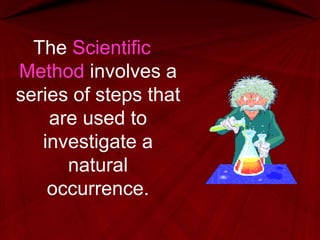
Scientific Method
- 1. The Scientific Method involves a series of steps that are used to investigate a natural occurrence.
- 2. Problem/Question Observation/Research Formulate a Hypothesis Experiment Collect and Analyze Results Conclusion Communicate the Results
- 3. Steps of the Scientific Method 1. Problem/Question: Develop a question or problem that can be solved through experimentation.
- 4. Steps of the Scientific Method 2. Observation/Research: Make observations and research your topic of interest.
- 5. Steps of the Scientific Method 3. Formulate a Hypothesis: Predict a possible answer to the problem or question. Example: If soil temperatures rise, then plant growth will increase.
- 6. Steps of the Scientific Method 4. Experiment: Develop and follow a procedure. Include a detailed materials list. The outcome must be measurable (quantifiable).
- 7. Steps of the Scientific Method 5. Collect and Analyze Results: Modify the procedure if needed. Confirm the results by retesting. Include tables, graphs, and photographs.
- 8. Steps of the Scientific Method 6. Conclusion: Include a statement that accepts or rejects the hypothesis. Make recommendations for further study and possible improvements to the procedure.
- 9. Steps of the Scientific Method 7. Communicate the Results: Be prepared to present the project to an audience. Expect questions from the audience.
- 10. Let’s put our knowledge of the Scientific Method to a realistic example that includes some of the terms you’ll be needing to use and understand.
- 11. Problem/Question John watches his grandmother bake bread. He ask his grandmother what makes the bread rise. She explains that yeast releases a gas as it feeds on sugar. John wonders if the amount of sugar used in the recipe will affect the size of the bread loaf
- 12. Observation/Research John researches the areas of baking and fermentation and tries to come up with a way to test his question. He keeps all of his information on this topic in a journal.
- 13. Formulate a Hypothesis After talking with his teacher and conducting further research, he comes up with a hypothesis. “If more sugar is added, then the bread will rise higher.”
- 14. Hypothesis The hypothesis is an educated guess about the relationship between the independent and dependent variables. Note: These variables will be defined in the next few slides.
- 15. Independent Variable The independent, or manipulated variable, is a factor that’s intentionally varied by the experimenter. (on x-axis) John is going to use 25g., 50g., 100g., 250g., 500g. of sugar in his experiment.
- 16. Dependent Variable The dependent, or responding variable, is the factor that may change as a result of changes made in the independent variable. (on Y-axis) In this case, it would be the size of the loaf of bread.
- 17. Control Group In a scientific experiment, the control is the group that serves as the standard of comparison. The control group may be a “no treatment" or an “experimenter selected” group.
- 18. Control Group The control group is exposed to the same conditions as the experimental group, except for the variable being tested. All experiments should have a control group.
- 19. Control Group Because his grandmother always used 50g. of sugar in her recipe, John is going to use that amount in his control group.
- 20. Constants All other factors stay the same so that any observed changes in the bread can be attributed to the variation in the amount of sugar.
- 21. Constants They might include: Other ingredients to the bread recipe, oven used, rise time, brand of ingredients, cooking time, type of pan used, air temperature and humidity where the bread was rising, oven temperature, age of the yeast…
- 22. Experiment John writes out his procedure for his experiment along with a materials list in his journal. He has both of these checked by his teacher where she checks for any safety concerns.
- 23. Trials Trials refer to replicate groups that are exposed to the same conditions in an experiment. John is going to test each sugar variable 3 times.
- 24. Collect and Analyze Results John comes up with a table he can use to record his data. John gets all his materials together and carries out his experiment.
- 25. Collect and Analyze Results John examines his data and notices that his control worked the best in this experiment, but not significantly better than 100g. of sugar.
- 26. Conclusion John rejects his hypothesis, but decides to re-test using sugar amounts between 50g. and 100g.
- 27. Conclusion John finds that 70g. of sugar produces the largest loaf. His hypothesis is accepted.
- 28. A Little Practice with the Scientific Method The next slide is a Bart Simpson scenario. Read it carefully, and see whether you can answer the associated questions.
- 29. Bart Simpson believes that mice exposed to microwaves will become extra strong (maybe he’s been reading too much Radioactive Man). He decides to perform this experiment by placing 10 mice in a microwave for 10 seconds (do not do this at home, Bart is a misguided fictional character ). He compared these 10 mice to another 10 mice that had not been exposed. His test consisted of a heavy block of wood that blocked the mouse food. He found that 8 out of the 10 microwaved mice were able to push the block away. 7 out of 10 non-microwaved mice were able to do the same. 1. What was Bart’s hypothesis? 2. Identify the Control group. 3. Identify the independent and dependent variables 4. What might be some of the possible constants? 5. What should Bart’s conclusion be?
- 30. ANSWERS 1. Mice exposed to microwaves will be extra strong 2. The unexposed mice 3. Independent variable- microwaves Dependent variable- strength 4. Same block of wood, same food, time of day, approx same size mice, etc. 5. Microwave exposure does not significantly change the strength of mice.
- 31. Let’s go down for the experimentation Activity
